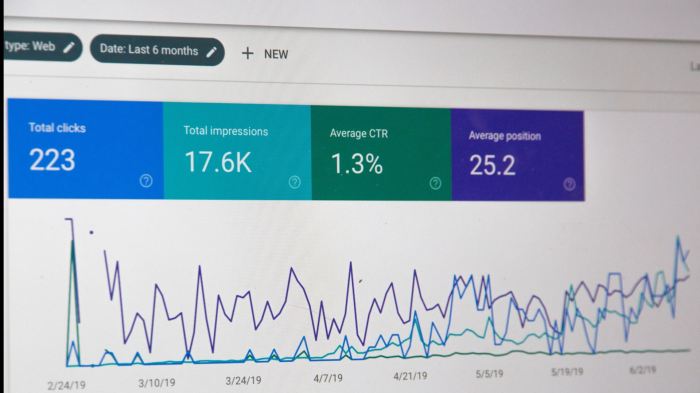Analyzing Website Traffic sets the stage for unraveling the intricate web of online data, offering businesses valuable insights into user behavior and preferences.
Understanding the flow of website visitors, deciphering patterns, and optimizing strategies are key components of this digital journey.
Understanding Website Traffic
Website traffic refers to the number of visitors who land on a website and the pages they view. It is a crucial metric for businesses to measure the popularity and effectiveness of their online presence.
Analyzing website traffic provides valuable insights into the behavior of users, such as which pages are most visited, how long visitors stay on the site, and where they are coming from. This information helps businesses make informed decisions to optimize their website for better user experience and conversion rates.
Data Collection and Measurement
Website traffic data is collected through various tools such as Google Analytics, which track user interactions on the site. Metrics like page views, unique visitors, bounce rate, and conversion rate are used to measure the performance of a website. Businesses can use this data to identify trends, assess the success of marketing campaigns, and tailor their content to meet the needs of their target audience.
Types of Website Traffic
Organic and paid website traffic are two primary sources of visitors to a website. Direct traffic and referral traffic also play crucial roles in driving audience engagement. Additionally, social media traffic has become a significant contributor to website visits in the digital age.
Organic vs. Paid Website Traffic
Organic website traffic refers to visitors who find your site through search engines like Google, Bing, or Yahoo without any paid advertising. On the other hand, paid website traffic involves paid advertising efforts such as Google AdWords, social media ads, or display ads to attract visitors to your site.
- Organic traffic is more sustainable and cost-effective in the long run compared to paid traffic.
- Paid traffic can provide quick results and targeted audience reach through precise ad targeting.
- Both organic and paid traffic strategies are essential for a comprehensive digital marketing approach.
Direct and Referral Traffic
Direct traffic consists of visitors who directly type your website URL into their browser or have your site bookmarked. Referral traffic, on the other hand, comes from external websites linking to your site.
- Direct traffic indicates brand loyalty and awareness among visitors who directly access your site.
- Referral traffic can help improve your website’s credibility and authority through backlinks from other reputable sites.
- Both direct and referral traffic sources are critical for establishing a strong online presence and driving organic growth.
Social Media Traffic
Social media traffic refers to visitors who discover your website through social media platforms like Facebook, Twitter, Instagram, or LinkedIn. Engaging content, shares, and interactions on social media can drive significant traffic to your site.
- Social media traffic provides an avenue for direct engagement with your audience and building brand awareness.
- Effective social media strategies can lead to viral content, increased website visits, and potential conversions.
- Utilizing social media analytics can help optimize your social media traffic and improve overall website performance.
Tools for Analyzing Website Traffic
When it comes to analyzing website traffic, there are a variety of tools available to help you track and understand the behavior of users on your site. These tools provide valuable insights that can inform your marketing strategies and help you optimize your website for better performance.
Popular Tools for Analyzing Website Traffic
- Google Analytics: This is one of the most widely used tools for monitoring website traffic. It provides detailed information about visitor demographics, behavior, and acquisition channels. With Google Analytics, you can track key metrics such as bounce rate, conversion rate, and average session duration.
- SEMrush: Another popular tool that offers comprehensive insights into website traffic. SEMrush provides data on organic and paid traffic, backlinks, and rankings. It also offers competitive analysis tools to help you benchmark your performance against your competitors.
- Ahrefs: A powerful tool for analyzing backlinks and organic traffic. Ahrefs allows you to track your website’s ranking for specific s, monitor your backlink profile, and identify opportunities for link building.
Google Analytics Features for Monitoring Website Traffic
Google Analytics offers a wide range of features to help you monitor and analyze your website traffic. Some key features include:
- Real-time data: Monitor visitor activity on your site in real-time, including active users, page views, and traffic sources.
- Audience demographics: Understand the characteristics of your website visitors, including their age, gender, location, and interests.
- Behavior flow: Visualize how users navigate through your site and identify potential bottlenecks or areas for improvement.
- Conversion tracking: Set up goals and track conversions to measure the effectiveness of your marketing campaigns.
Understanding User Behavior with Heatmaps
Heatmaps are a valuable tool for understanding user behavior on a website. By visualizing where users click, scroll, and spend the most time on a page, heatmaps can provide insights into user engagement and preferences. Heatmaps can help you identify popular areas of your website, optimize your layout for better usability, and improve conversion rates by focusing on elements that attract the most attention.
Interpreting Website Traffic Data: Analyzing Website Traffic

When it comes to analyzing website traffic data, understanding key metrics is crucial in gaining insights into the performance of your website. Metrics such as sessions, page views, bounce rate, and conversion rate can provide valuable information on how users interact with your site and the effectiveness of your content and marketing strategies.
Key Metrics
- Sessions: This metric represents the number of visits to your website within a specific timeframe. It gives you an overall idea of how many users are engaging with your site.
- Page Views: Page views indicate the number of times a specific page on your site has been viewed. Tracking page views can help you identify which pages are popular and engaging for users.
- Bounce Rate: The bounce rate shows the percentage of visitors who navigate away from your site after viewing only one page. A high bounce rate may indicate that your website content or user experience needs improvement.
- Conversion Rate: The conversion rate measures the percentage of visitors who complete a desired action on your site, such as making a purchase or filling out a form. A high conversion rate indicates that your website is effectively converting visitors into customers or leads.
Identifying Trends and Patterns
Analyzing website traffic data can help you identify trends and patterns over time. By tracking metrics like sessions, page views, and conversion rate on a regular basis, you can spot changes in user behavior, popular content, or successful marketing campaigns. This information can guide you in making data-driven decisions to optimize your website performance.
Analyzing Traffic Sources
Understanding the source and medium of your website traffic is essential in determining the effectiveness of your marketing efforts. By analyzing where your traffic is coming from (e.g., organic search, social media, referral sites), you can allocate resources to channels that drive the most traffic and conversions. This insight can help you refine your digital marketing strategy and improve overall website performance.
Improving Website Traffic

Increasing organic traffic to a website is essential for its success. Organic traffic refers to visitors who come to your site through unpaid search results. Here are some strategies to boost organic traffic:
Role of in Boosting Website Traffic
, or Search Engine Optimization, plays a crucial role in driving organic traffic to a website. By optimizing your website’s content and structure for search engines, you can improve your site’s visibility in search results. Here are some key tips for leveraging to boost website traffic:
- Conduct research to identify relevant s for your content.
- Optimize on-page elements such as meta tags, headings, and image alt text with targeted s.
- Create high-quality, valuable content that is optimized for both users and search engines.
- Build high-quality backlinks from reputable websites to improve your site’s authority.
- Regularly monitor and analyze your website’s performance using tools like Google Analytics to make data-driven decisions.
Tips for Optimizing Landing Pages to Enhance Website Traffic, Analyzing Website Traffic
Landing pages are crucial for converting website visitors into leads or customers. Optimizing your landing pages can help increase website traffic and improve conversion rates. Here are some tips for optimizing your landing pages:
- Create clear and compelling calls-to-action (CTAs) that encourage visitors to take the desired action.
- Simplify the design and layout of your landing pages to improve user experience and reduce bounce rates.
- Use A/B testing to experiment with different elements on your landing pages and identify what resonates best with your audience.
- Ensure that your landing pages load quickly and are mobile-responsive to cater to users on all devices.
- Incorporate social proof, such as customer testimonials or reviews, to build credibility and trust with visitors.












